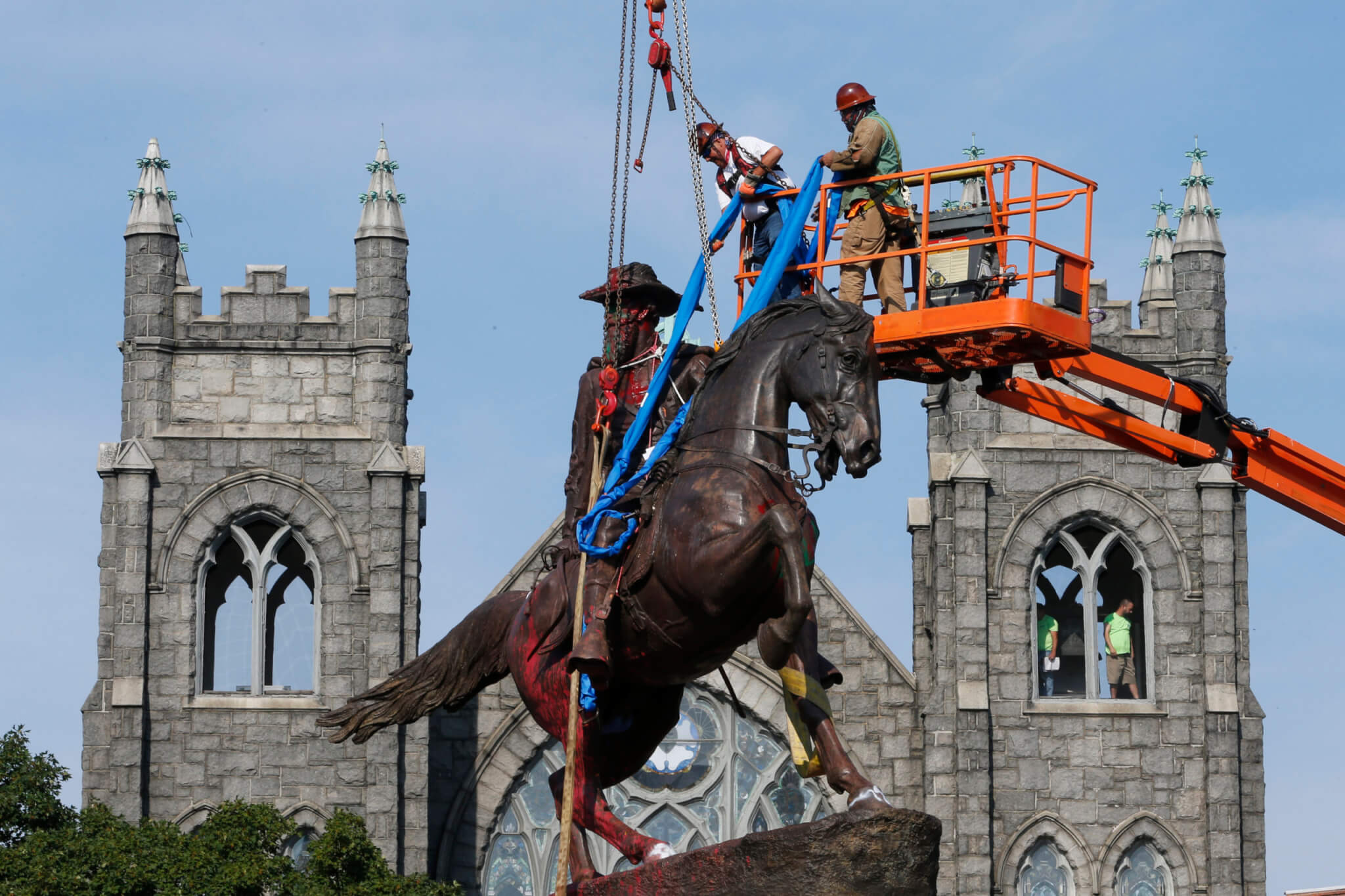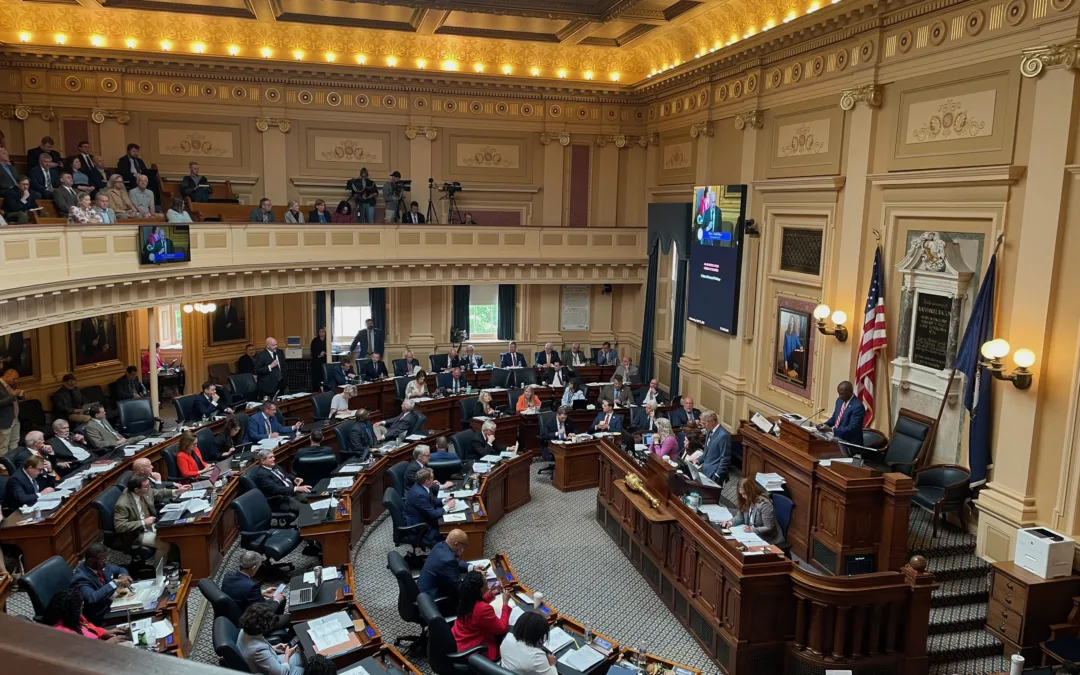
Crews attach straps to the statue Confederate General J.E.B. Stuart on Monument Avenue Tuesday July 7, 2020, in Richmond, Va. The statue is one of several that will be removed by the city as part of the Black Lives Matter reaction. (AP Photo/Steve Helber)
The Virginia House passed a bill making it easier to remove any type of war memorial or monument. The Senate, meanwhile, has a bill focused on the exact opposite intent.
RICHMOND-If the Virginia House has their way, it’ll soon be easier to remove any type of war monument in Virginia. That includes everything from Confederate monuments to World War II memorials. On Tuesday, the House passed HB5030, which removes multiple requirements cities or counties have to follow before removing any type of monument.
Passing by a 54-43 vote, the bill gives cities or counties the authority to “remove, relocate or alter” any monument or memorial for war veterans. That goes for any monument located within the city or county’s geographic limits. The proposal would also end several longtime requirements. Currently, before removing a monument, a city or county has to announce its plan to do so in a newspaper and hold a public hearing. If the city council or county supervisors vote to remove it, then they have to wait at least 30 days to see if a museum, historical society or any other operation wants to take the monument. This bill eliminates all those requirements. If a council votes to remove a monument, under this bill they could simply go out that same day and tear it down without waiting.
Now it’s worth pointing out this covers more than just the Confederate monuments. Monuments ranging from 1622 to 2003 fall under this. That includes any tribute from the Algonquin War, French and Indian War, Revolutionary War, War of 1812, Mexican War, the Civil War, the Spanish-American War, World War I, World War II, Korean War, Vietnam, Operation Desert Storm, Operation Enduring Freedom and Operation Iraqi Freedom. Memorials from all of those wars fall under this bill.
Cutting Out Hearings Raises Concern
Even before Tuesday’s vote, portions of the bill raised concern. Speaking Friday afternoon in session, Del. Charles Poindexter (R-Franklin) asked why it was necessary to remove the public’s involvement.
“Whenever our local government makes a land use change or demolishes something, we always have public hearings and we always have public notice,” Poindexter said. “[To] not have that with monuments, that’s just not good governance.”
Poindexter also questioned if the House should pass a bill like this when lawsuits are still going through the courts. In Richmond, for example, the statue of Robert E. Lee has to stay in place until at least October, due to a judge’s order. In June, Gov. Northam labeled the statue as a racist symbol and ordered it taken down. This was supposed to be done in two phases, with an onsite inspection. In response, residents of Richmond’s Monument Avenue filed a lawsuit to keep the statue in place, arguing that removing it damages their property values. The lawsuit is set for Oct. 19 and until then, the monument has to stay in place. The General Assembly should let cases like that get settled before passing a bill, Poindexter argued.
However, that hasn’t typically been General Assembly policy, regardless of which party is in charge. In multiple cases, the Assembly passed a bill which was then used by the judge to issue a ruling. During Tuesday’s session, House members from both parties decided to send it on to the Senate for debate.
A Clash Coming in The Senate?
Now the bill goes to a body that just passed a very different idea involving monuments. Last week, the Senate unanimously approved SB5407. It stops removal of all Confederate artifacts from government buildings unless the Capitol Square Preservation Council signs off. The Capitol Square Preservation Council received the power to “review and approve all plans or proposals for alterations, improvements, additions or renovations to, or other disposition of, any monuments, statuary, artwork or other historical artifacts contained within the Capitol Building.”
That includes both the old and new Senate chambers, the old and new halls of the House of Delegates and the Capitol Rotunda.
Now the bills switch sides, as the House version goes to the Senate for debate and vice versa.
Politics

Youngkin, Democrats to start over on budget talks
The Republican governor stood with Democratic leaders in the General Assembly on Wednesday in a bid to ease tensions over their budget debate....

VIDEO: Domestic abuse victims speak out against the gun law bills Gov. Glenn Youngkin vetoed
Senate Bill 47 and House Bill 46 aim to close the loophole that allows offenders to transfer their firearms to someone else instead of relinquishing...
Local News

Virginia verses: Celebrating 5 poetic icons for National Poetry Month
There’s no shortage of great writers when it comes to our commonwealth. From the haunting verses of Edgar Allan Poe, who found solace in Richmond's...

Join the fun: Recapping Family Literacy Night’s storybook adventures
When’s the last time you read a book aloud with a loved one? If it’s difficult to answer that question, then maybe it’s time to dust off that TBR...




